



Management Practices To Reduce Expensive Feed Wastage
By J. Carr - Murdoch University, Department of Production Animal Health and Medicine, Portec, P.O. Box 331, Belmont, Australia WA 6984. The Pig Journal Proceedings Supplement 1, due out April 2008.Summary
PIG JOURNAL
PROCEEDINGS SUPPLEMENT 1
Due April 2008.
Buy the current edition of the Pig Journal (60) here.

In a time of record feed prices, it is essential that feed wastage be minimized. It is estimated that 10% of feed delivered is wasted on the average farm. On a 250 sow unit, this can be more than 150 tonnes of feed per year (whole farm - farrow to finish - feed consumption at 6.3 tonnes per sow per year). Feed is wasted along the entire feed line from field to rectum!
This article details some of the areas where this wastage occurs at the farm level and focuses on simple management practices to reduce this waste. Reducing feed wastage by half would amount to a reduction in cost of 8-9 AuCents/kg deadweight - Au$6.30 per pig sold (70kg dead weight, head off - Western Australia norm). This could be the difference between profit and loss on many farms. (Calculation: 7.5 tonnes x Au$377 average feed price divided by (250 x 20 x 70kg) dead weight).
Where is feed wasted?
Feed distribution system and storage
Feed bin managementAvoid unnecessary waste while cleaning feed bins. Leaving spilt feed under the bin only encourages rodents and vermin to the farm - which then consume their own share of feed. Routinely and regularly check the outside and inside of feed bins and their distribution systems.
Feed bin filling
When the feed bin is being filled, avoid all wasted and spilt feed. Once the feed has been delivered, ensure that the feed bins are properly re-sealed.
Feed spillage
Manage and understand feed movement within a feed bin and ensure that feed spillages do not occur. If a pig is without feed for 24 hours, a gastric ulcer may occur. This results in poor feed digestion and leakage of blood, which has to be replaced - a chronic feed wastage. Pigs going without feed for more than 6 hours is extremely common on pig farms - to the point where it is a normal occurrence at least once in every batch of pigs produced.
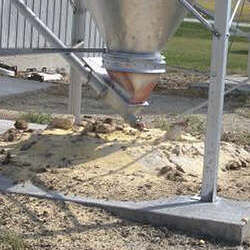 Feed spillage under a feed bin. |
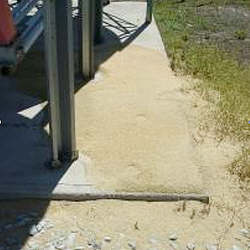 Feed being spilt during delivery. |
Feed storage
Creep feed should not be exposed to temperature extremes for if it gets hot, it might go stale. A typical example of this is "storing" creep feed within the hot nursery, making the feeding easier for the stockperson.
Feed barrows
If feed is moved around the farm in barrows, ensure that the barrow is kept out of the rain and is covered at all times. Do not overfill feed barrows as this often leads to spillage of feed whilst moving the barrow around the farm.
Wastage associated with medications in the feed
Place medicated feed into the correct bin. Ensure that all feed bins are numbered and the driver places the correct feed in the correct feed bin. This will avoid having to empty a feed bin or having to live with unintended and expensive medication withdrawal times.
Palatability
All feed which enters the farm should be tasted by the stockperson in charge of the area and the manager to ensure that feed palatability standards are being met. This should include wet feed ingredients.
Do not allow medication to make the feed unpalatable. If there is any concern regarding palatability, consider the use of talins to mask the taste. Discuss this with your veterinarian if you have any concerns.
Specifically,
- Do not store creep feed at high temperatures.
- Do not allow feed barrows to waste feed.
- Number all feed bins and regularly check.
Feeder setup
Adequate feed space
To allow all the pigs to grow evenly, it is essential to provide sufficient feeder space for all the pigs in the pen. This is particularly important in the first three days post-weaning.
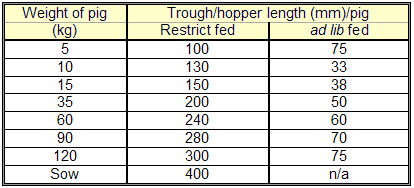
Note that the newly weaned pig requires 3x longer feed space than is required a week later. This is because newly weaned pigs feed as a group and do not understand the concept of ad lib feeders.
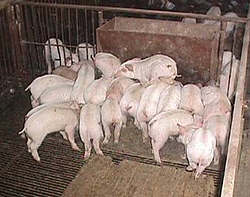 Weaned pigs having to fight over feed when there is insufficient feed space. |
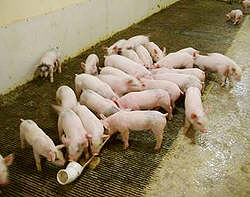 The use of a narrow trough can enhance post-weaning feed intake. |
Feed distribution
Ensure that the feed is distributed evenly along a feeder to minimize aggression and fighting at the feed space. This will also minimize uneven growth within a group of pigs. Do not place the feeder on a sloped floor.
Feeder in wrong position in the pen
When siting the feeder, consider the ability of the pig to reach it. Feeders placed in cold corners will often become fouled with urine and faeces as the pigs use the area as a toilet. Feeders placed too close to a divider or other obstacle, a drinker for example, may have feed spaces which are inaccessible. Note, pigs should not have to jump up to gain access to the feeder. This is typically seen when young pigs have to cope with raised feeders.
Feeders placed so that they cannot be easily examined
All feeders should be placed so that the stockperson can easily examine the feeder for leakage, overflowing of feed, or soiling.
Feed and drinker position
Pigs like to drink shortly after feeding. If the drinkers are more than 2 metres from the feeder, pigs will walk between the feeder and drinker and carry food in their mouths. This feed will be dropped (and wasted) on the floor and bedding. Ensure that the pigs do not have to cross the sleeping area to get from the feeder to the drinker.
Covering feeders
Uncovered feeders contribute up to 30% of the dust in the air. The feeder is exposed to rodents and possibly birds, which can both eat the feed and soil the remaining feed. All feeders should be covered. If the stockperson needs to examine the feed level, ensure that the feeder has a see-through area where this can be assessed.
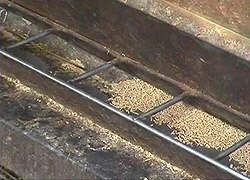 Poor feed distribution. Ensure that the downpipe is properly placed. |
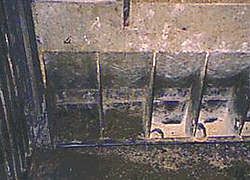 Feeder in the wrong place in the pen and being used as a toilet area. |
Management
Use the right feed at the right time
It is essential that pigs progressively move to the cheaper diets as soon as possible, while maximizing their growth potential. Keeping pigs on the expensive early diets for longer than warranted, increases costs. On several farms, the pigs are kept on expensive weaner diets too long to compensate for the poor feed intake and growth in the first week post-weaning. Carry out regular feed budget audits to ensure that the farm is feeding appropriate levels of feed intake.
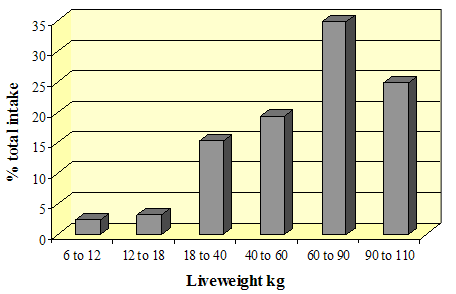
Use correct feed
It is essential to adopt a suitable diet. In times of high prices, it is tempting to simplify and cheapen the feed, but growth and health could be affected. Note if the pig's growth slows down, this cannot be allowed to affect pig flow and all-in/all-out systems. Poorly formulated diets are more likely to result in diarrhoea, resulting in raw feed ingredients ending up on the floor.
Feed preparation
Feed which is incorrectly prepared - ground or rolled, can result in increased waste. Whole grains cannot be digested by the pig and are passed out whole and undigested - and are therefore wasted.
Feed available when pigs enter a house
It is essential that pigs are fed the correct diet immediately when they enter the house. Requiring the pigs to eat up the last of the previous group of pigs' feed is not acceptable. Such feed may contain the incorrect ingredients or medications, or if it has been left for more than a couple of days, has become soiled with moulds, rodent faeces or urine.
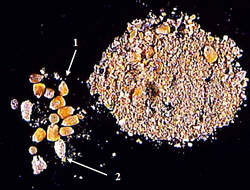 Pigs cannot digest whole maize grains (arrow 1) - they pass through the pig, thus wasting the original feed. Note also the cotton seed (arrow 2) - these may carry the toxin gossypol. |
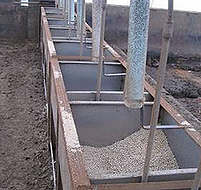 Final finishing feed left to be eaten by the next group of 30 kg pigs. Note the feeders are not covered. |
Feeding routines
Creep feeding in the farrowing house
If the farm practises 3-week weaning, creep feeding needs to be carefully justified. It must be demonstrated that the effort and waste involved in creep feeding enhances weaning weights and post-weaning feed intakes. With 4-week weaning, creep feeding can be beneficial. However, it must be practised so that expensive creep feed is not wasted and soiled. Creep feed should be fed at least 3 times daily - little and often.
Adult pig feeding
The feeding routines practised in the farrowing, breeding and gestation areas can result in enormous feed wastage. In the farrowing area, attempting to get the sows to eat too fast can result in loss of appetite in the lactating sow. The pig then fails to clean out the feed trough, resulting in mould development and, in the worst cases, fly infestation of the feed. Note, the feed problems can result in water availability problems affecting milk supply to the piglets.
In the breeding area, when sows are in oestrus they often will not eat and this results in feed remaining in the feed troughs and being wasted.
In gestation areas, feeding routines can be extremely careless, resulting in large amounts of feed being wasted on the floor. Combined with poor cleaning routines, this feed becomes soiled. Overfeeding of the gestating sow is extremely common on pig farms. This extra feed is wasted, does not benefit the growing piglets and reduces subsequent feed intake during lactation.
Emptying feeders when pigs leave the farm
Do not dispose of feed remaining in the feeder by pressure washing the feed down the slats. Management of the feeder in the finishing pen is an essential component of finishing.
Hospital pen feeders
The feeders in the hospital pen are often over-full and over-running for only one or two pigs. This can result in tremendous wastage. Adjust feed in the hospital pen feeders according to the needs to the pigs.
Weekend feeding
It is extremely lazy to overfill feeders - especially in the newly weaned pens, with feed just to avoid having to feed at the weekend. We all want an easy a life, but this laziness can result in wasted and soiled feed.
Feeder management
Holes in the feeder
It is imperative that all feeders are examined regularly - at least between batches. Where a feeder is found to have a hole, fix or replace the feeder. Holes that occur over slats cost enormous amounts of money, where chronic feed leakage occurs without trace. Note, holes can occur in down-pipes and feed systems - sometimes out of sight.
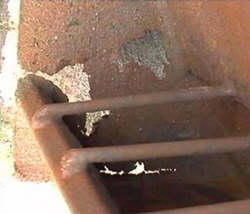 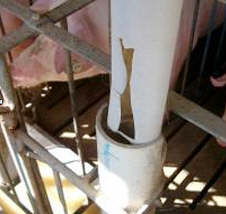 Any feeder with a hole should be thrown away or immediately repaired. |
Feed quantity available
The adjustment of feeders should be made every day. This is one of the most important jobs for grow/finish stockpeople. It is not acceptable that feeders are allowed to over-run just to ensure pigs have "sufficient" feed. Feed efficiency can be maximized when the pigs have to work for their feed. Placing less feed in the feeder by lowering the downpipe into the feeder will reduce feed wastage and dust production, although the feed auger may need to run more often. All stockpeople should understand in detail how the feeder works and how to adjust the feed availability. A feeder, which is over-running, will also tend to allow the feed to become powder. This can result in feed intake refusal, increased dust contamination of the room, limited feed space and increased respiratory problems in the pigs.
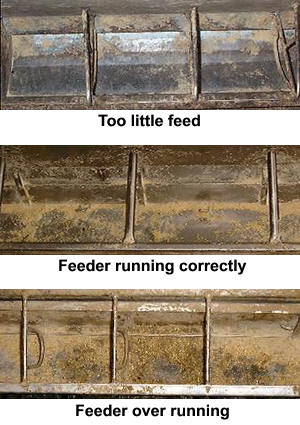

Three different feeder designs, all providing too much feed, resulting in feed wastage.

1. Very powdery feed being fed.
2. Analysis of the feed in the feed bin - very little powder.
3. Analysis of the feed in the feeder - a lot of powder, very few pellets.
Ignoring over-running feeders
If stockpeople are in too much rush, they may miss a feeder which is over-running. A personal example: the downpipe fell out of the feeder and the auger tried to fill the slurry pit over the weekend. The result: 30 tonnes of wasted feed, as well as the time taken to dig out the slurry pit by a young stockperson - who would never make that mistake again! Obviously, large quantities of feed can be wasted within hours. Feeders and feed systems should be equipped with suitable alarms to prevent this occurrence.
Water in the feeder

Excessive water in the feeder can result in feed waste and obstruction to feed intakes.
Any feeder with an additional waterer should receive careful management. Ensure that the water does not leak and fill the feeder, restricting feed access. Likewise, ensure that feed does not build up and limit water availability. Drinkers in feeders should be considered as feed intake enhancers, not as a specific water supply.
Soiling of the feed
Feeder incorrectly placed
As discussed above, ensure the feeder does not look like a toilet area to the pig.
Effects of the weather and the feeder
The feed must not be spoiled by the effect of the weather - in particular, during rain storms. This is to include feed barrows and bagged feed areas.
Floor feeding/feed as bedding
Floor feeding, for whatever reason, should be avoided. Feed is an extremely expensive bedding material. Whilst it is not uncommon post-weaning to feed on the floor mat, the provision of a simple, inexpensive trough will not only reduce waste, but also provide the stockperson with details of feed consumption per pig, rather than just usage per group.
Particularly surprising is the number of farms where feed is spread on the floor merely to indicate to the pigs where their "sleeping area" is located. Review pen layout and provide a draught-free sleeping area to all pigs.
Mouldy feed
The feed can become soiled by water running into a feeder - for example, from a drip cooling system, poorly managed. This wet feed can rapidly become mouldy and fly- infested. Feed bins which are not sealed after filling, or are sited where condensation can occur in the bin, result in feed wastage through mould. Feed bins placed directly in front of outlet fans are an example of this. Mould not only results in wastage, but is a potential health risk if feed is eaten.
Farrowing and gestation sows
Adult sows' feed supplies are particularly prone to soiling through attempts to overfeed by stockpeople.
Rodent and vermin control
Birds, mice and rats can consume vast quantities of pig feed. Their faeces and urine contribute to the soiling of even more feed. Feeders should be covered, to reduce access to vermin. Buildings should be bird-proofed to reduce access and thereby improve salmonella control.
FCR has been reduced by 0.3 (3.0 to 2.7 - 30-100 kg liveweight) in sheltered pigs, purely by covering the feeder! In outdoor units, seagulls and birds can swoop down and take several pellets at one time. What is particularly galling is that the sows will often stand to one side while the birds eat!
An adult rat will eat 15g a day - with 1000 rats on a farm, this is nearly 5.5 tonnes per year.
A seagull will eat 100g a day - 100 seagulls eating their ration a day tallies up to 3.7 tonnes of food per year.
Avoid feeding unnecessary animals
Non-pregnant sows
It is essential that all sows 6 weeks post-mating are actually pregnant. A sow which is discovered not to be pregnant in week 16 of 'gestation' has just consumed 175 kg (2.5x7x10) of feed since mating. On many farms, this can be as many as 7% of sows. On a 250-sow unit, this is accounts for 3 tonnes of sow feed a year.
Cull sows
Once the decision to cull a sow is made, ensure that she is culled as soon as possible. Cull sows are eating 2.5 kg a day.
Feeding finishing pigs prior to slaughter
To feed a pig immediately prior to slaughter, wastes 2.5 kg per pig sold. In addition, it can make the journey to the slaughterhouse extremely unpleasant for the pigs by inducing vomiting and travel sickness.
Overweight finishing pigs
Finishing pigs must be weighed and sold into the slaughterhouse matrix. Outside the box, the pig becomes extremely expensive. When they get to 120kg with a P2 of 16 mm not only are they not going to pay for the extra feed they have consumed, but they are going to result in a penalty at the slaughterhouse, reducing their return.
Review culling of runt pigs
Pigs which are born small and/or are weaned as a runt, should have their survivability carefully reviewed. Ninety percent of pigs born below 800g die before reaching slaughter weight. Small, weak born piglets have FCR rate 3.5 to 4.0 instead of 2.4 to 2.6. The feed cost of these animals needs careful review.
Sick pigs
Review the pigs in the hospital area. Rectal strictures are not uncommon on pig farms. These pigs will often have ravenous appetites, but they will not be suitable for marketing. In the hospital area, tag all pigs and review after 7 and 14 days post-entry. Cull quickly all pigs that are not going to be marketable.
Ileitis and chronic diseases
Ileitis is associated with the bacterium Lawsonia intracellularis. This disease results in chronic feed waste as it increases the thickness of the gut, resulting in less digested feed being absorbed into the pig. This can result in a loss of growth of 40g a day, which, at a FCR of 3, is 120g a day of extra feed eaten.
Partial and full de-population?
If the disease problems on the farm become chronic, consider a partial or even full de-population to allow for full cleaning and refurbishment of the farm. A reduction in 0.5 FCR is not uncommon on farms post-partial de-population. Animals that have to live in a heavy pathogen load environment have to divert nutrients from growth to immunological defence, thus wasting feed.
Gastric ulcer
In general, gastric ulceration occurs because the pig fails to eat over a 24 hour period. If the feed is very fine (<700 m) the feed will then aggravate an existing gastric ulcer. Gastric ulcers result in feed wastage by poor feed digestion and chronic anaemia. In addition, the pig is weakened and more prone to secondary infections and bullying by other pigs.
Avoid feeding for unnecessary activity
Exercise energy: Mis-placed drinkers
It costs feed to have the pigs walk unnecessary distances to the drinkers. In addition, the pigs will carry and drop feed between the drinker and the feeder. Place the feeders no further than 2 metres away from a drinker.
Wet bedded areas
If the bedding area is very wet and boggy, the pig will struggle to move around the pen. This can be a particular problem in deep, straw-bedded systems, shelters and hoops, and can add 0.2 FCR onto the feed bill.
Air temperature and comfort
Ensure that you keep the pigs within their thermo-comfort zone. If the pigs are housed too cold, feed will be consumed to help keep the pig warm. If the pigs are too hot, feed consumption will drop and therefore growth, but, in addition, extra effort will be expended to pant, to help the pig loose heat. In the farrowing area, feed only at the cooler times of the day.
How much is feed wastage costing you?
The impact of feed wastage
The cost of feed wastage is demonstrated in Table 2.
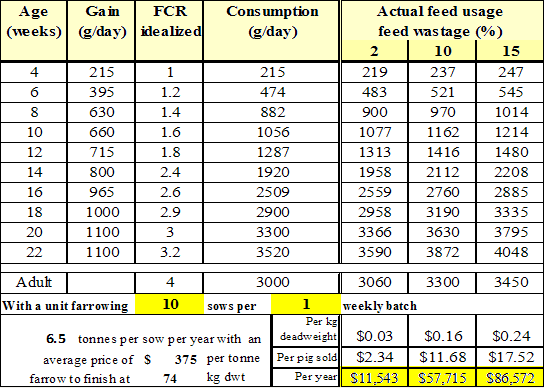
To survive today's feed prices, we must minimize feed wastage to minimize cost of production.
February 2008








